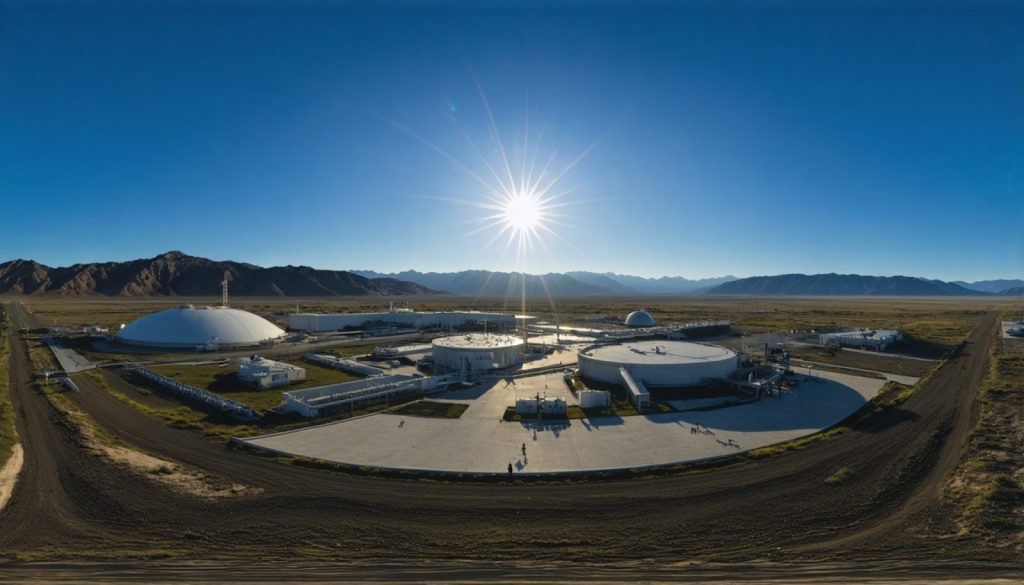
- Scientists at Idaho National Laboratory are advancing clean energy by developing a fusion blanket for future fusion reactors.
- The fusion blanket recycles tritium fuel, converts neutron energy into heat for electricity, and protects reactor components.
- This research is crucial for climate change solutions, offering an alternative to fossil fuels and hazardous fission waste.
- The project is part of the Department of Energy’s Fusion Innovative Research Engine, aiming for a functional fusion fuel cycle within a decade.
- Using existing fission facilities at INL reduces costs and facilitates rapid development of fusion technology.
Nestled in the sweeping, rugged landscapes of Idaho, a group of visionary scientists are embarking on a groundbreaking endeavor that edges humanity closer to an age of unlimited clean energy. This ambitious pursuit unfolds at the Idaho National Laboratory (INL), where researchers are ingeniously leveraging existing nuclear fission technology to test a vital component of future fusion reactors: the fusion blanket.
Imagine a world powered not by fossil fuels or fission reactors bursting with radioactive waste, but by the same process that fuels the sun—nuclear fusion. Unlike its counterpart, nuclear fission, fusion promises an energy source free from the shackles of hazardous waste, signaling a vibrant future where energy scarcity is but a relic of the past.
At the heart of this thrilling prospect lies the fusion blanket, a complex, multi-faceted component designed to cradle the searing plasma core of fusion reactors. Think of it as the silent, vigilant guardian that performs a trio of essential duties. First, it recycles fuel by breeding tritium—an essential but scarce component in fusion reactions—from lithium within its folds. Second, it captures the kinetic dance of neutrons, deftly transforming this energy into heat, which in turn spins turbines to generate electricity. Lastly, it shields the reactor’s delicate magnets from the neutron storm, ensuring the whole machinery remains unscathed.
The Idaho lab, already recognized for its prowess in nuclear fission, was strategically chosen as one of the six premier research centers by the Department of Energy’s Fusion Innovative Research Engine collaboratives. These centers form the nucleus of America’s fusion ambition—an ecosystem that aims to fashion an operational fuel cycle within the span of a decade.
Why the rush to perfect these fusion blankets? The answer is urgent and clear: climate change. Fusion energy holds the potential to eclipse the fossil fuel era, presenting an abundant and clean alternative to the sooty culprits of our warming planet. Testing this technology at INL within a fission framework allows scientists to refine and perfect fusion processes without the prohibitive costs of building new fusion-only facilities—something quite prudent in a field where innovations are both critical and costly.
The fusion blanket initiative builds momentum as the world watches intently, hopeful that the elusive promise of fusion energy—once mere science fiction—will soon light up cityscapes as effortlessly as the morning sun cresting the Idaho hills.
Stay informed with our free newsletter that tracks these pivotal innovations and more, capturing the spirit of contemporary discovery and a shared future powered by science and ingenuity.
Unlocking the Secrets of Fusion Power: How Idaho’s Scientists Are Pioneering the Future of Clean Energy
Understanding the Fusion Blanket’s Role in the Energy Revolution
In a world urgently seeking sustainable energy solutions, the fusion blanket stands out as a pivotal advancement in the quest for clean power. Here’s what you need to know about this promising technology and how it could revolutionize our energy future:
1. How the Fusion Blanket Works:
– The fusion blanket serves three crucial functions. It breeds tritium, generates heat to produce electricity, and protects reactor components from damage.
– It uses lithium to breed tritium, leveraging chemical reactions that are crucial for sustaining the fusion process.
2. Real-World Use Cases:
– Fusion power plants equipped with these blankets could become primary energy sources, reducing reliance on fossil fuels and cutting greenhouse gas emissions significantly.
– When paired with smart grid technologies, they can offer stable energy supplies, minimizing fluctuations typical in other renewable sources like solar and wind.
3. Market Forecasts & Industry Trends:
– The global fusion energy market is poised to grow as advancements like the fusion blanket become commercialized. Experts predict increased investment in fusion technologies as governments strive to meet climate targets.
– Innovations in materials and reactor designs will further accelerate the path towards practical fusion energy production.
4. Pros and Cons Overview:
– Pros: Virtually limitless fuel supply, no long-lived radioactive waste, minimal environmental impact.
– Cons: High initial costs, technological challenges in containing and sustaining fusion reactions.
5. Tutorials & Compatibility:
– For researchers and engineers interested in the field, platforms like Idaho National Laboratory provide opportunities to collaborate on fusion technology advancements.
– Compatibility with current renewable energy infrastructure ensures seamless integration into existing grids.
6. Security & Sustainability:
– Fusion energy presents fewer security risks compared to fission, as it produces no long-lived radioactive waste and involves no chain reactions.
– Sustainable practices in sourcing lithium and other materials are crucial, ensuring minimal environmental impact.
7. Controversies & Limitations:
– Skepticism remains about the timeline for achieving commercially viable fusion power, with critics noting the decades-long history of unfulfilled promises.
– Ongoing debates focus on the feasibility of building and maintaining fusion reactors at scale.
8. Insights & Predictions:
– Experts anticipate that within the next two decades, fusion power could become a significant contributor to the global energy mix, particularly if breakthroughs in reactor technology and cost reduction occur.
9. Actionable Recommendations:
– Policymakers should increase funding for fusion research and address regulatory barriers to expedite deployment.
– Continued international collaboration will be crucial, pooling resources and expertise to overcome technical challenges.
Stay Updated with Cutting-Edge Energy Innovations
For those eager to follow the latest developments in fusion technology and other groundbreaking scientific advancements, subscribing to updates from prominent research institutions like INL is imperative. This will ensure you stay informed about new breakthroughs and opportunities in the renewable energy sector, enhancing your understanding and engagement with these transformative innovations.



